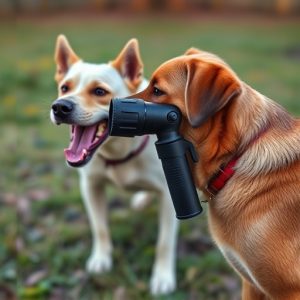Canine Pepper Spray: Pet Safety & Police Applications Under Scrutiny
Self-defense spray regulations, particularly for canine pepper spray in police settings and among pe…….
Self-defense spray regulations, particularly for canine pepper spray in police settings and among pet owners, aim to balance public safety with responsible pet ownership. Clear guidelines are essential for safe and effective use, as misuse poses significant risks to pets. Understanding the spray's effects, range, wind conditions, and local laws regarding possession and use is crucial to protect both humans and animals from harm.
“Unleashing the power of self-defense in the canine realm, this article explores an unconventional yet powerful tool—canine pepper spray. From its origins as a police-grade defense mechanism to its potential for pet safety, we delve into the intricacies of understanding and regulating this potent spray.
We’ll navigate the debate surrounding its use on pets, debunking myths and emphasizing responsible handling. With a focus on Self Defense Spray Regulations and Pets, this comprehensive guide offers insights into ensuring safety while considering unique animal welfare aspects.”
- Understanding Canine Pepper Spray: A Tool for Self-Defense and Its Police Applications
- Regulating Self-Defense Spray: Pets and Safety Considerations
- Pet Safety and Canine Pepper Spray: Debunking Myths and Ensuring Responsible Use
Understanding Canine Pepper Spray: A Tool for Self-Defense and Its Police Applications
Canine pepper spray, a specialized self-defense tool, has gained attention for its unique capabilities in law enforcement and personal safety. This non-lethal spray is designed to temporarily incapacitate an aggressor, providing individuals with a means of escape or time to seek help. The primary focus of this technology lies in its regulation and responsible use, especially when considering the well-being of pets.
In police settings, canine pepper spray is employed in situations where traditional force may not be appropriate or effective. It offers a balanced approach to crowd control and animal handling, allowing officers to manage potentially dangerous scenarios without causing permanent harm. Self-defense spray regulations vary across regions, but their purpose remains consistent: to ensure the safety of both individuals and pets while maintaining public order.
Regulating Self-Defense Spray: Pets and Safety Considerations
The regulation of self-defense spray, including canine pepper spray designed for police grade use, involves a delicate balance between public safety and responsible pet ownership. As the popularity of self-defense sprays increases, so does the need for clear guidelines to ensure their safe and effective use. These regulations are particularly important when considering the potential impact on pets and other animals. Pet owners must be aware of local laws regarding the possession and use of self-defense spray, especially in areas where pets are common.
When it comes to self-defense spray regulations, pets present unique considerations. Spraying an animal, whether a pet or wild creature, requires extreme caution due to their sensitivity to irritants. Police-grade pepper spray, with its potent formula, must be handled and applied differently around animals compared to human targets. Responsible pet owners should educate themselves on the legal limits and safe application methods to protect both themselves and their pets from accidental harm.
Pet Safety and Canine Pepper Spray: Debunking Myths and Ensuring Responsible Use
Canine pepper spray, while often portrayed as a powerful tool for self-defense against aggressive dogs, raises concerns about pet safety. Many myths surround its responsible use, especially when considering its potential impact on beloved family pets. It’s crucial to debunk these misconceptions and promote informed decisions regarding self-defense sprays to ensure the well-being of both humans and animals.
The primary regulation around self-defense spray, including canine pepper spray, focuses on responsible usage. Users must be trained to identify appropriate situations for its application and understand the effects on different species, including pets. Unlike in law enforcement scenarios, where pepper spray is used sparingly against humans due to strict regulations, pet owners need to exercise caution when considering its use as a deterrent against dogs. Myth-busting education emphasizes that this spray should be a last resort, especially around pets, and highlights the importance of alternative methods like training, fencing, and positive reinforcement in dog management. Responsible use involves understanding the spray’s range, wind conditions, and the animal’s behavior to minimize off-target effects and ensure the safety of all involved.
Canine pepper spray, a powerful self-defense tool, offers unique advantages in law enforcement and pet safety. However, it’s crucial to navigate its use responsibly, addressing regulatory concerns regarding pets and ensuring these potent agents are employed ethically within self-defense frameworks. By understanding the dynamics of canine pepper spray, we can foster safer communities where both humans and their four-legged companions thrive.


